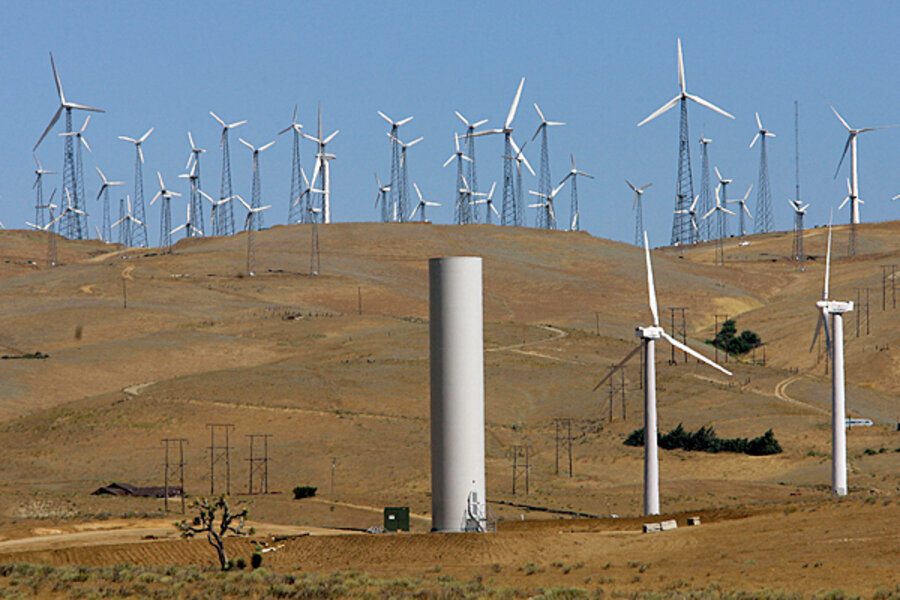Can huge Mojave wind farm boost faltering wind power industry?
Loading...
What some tout as the nation's biggest wind power plant broke ground last week in the Mojave Desert, where its developers hope to one day spin enough giant wind turbines to equal the generating capacity of three nuclear power plants.
The Alta Wind Energy Center being built by Terra-Gen Power of New York is a major gust of renewable energy. It has 290 wind turbines spread across 9,000 acres 75 miles north of Los Angeles and is expected to serve 275,000 homes – for starters.
If demand stays strong, a second group of 300 turbines is planned for 2015 and later additions could grow the operation to 3,000 megawatts and millions of customers.
IN PICTURES: The answer is blowing in the wind
But all that wind-energy optimism blowing in southern California belies an uncharacteristically weak and bleak short-term outlook for US wind power. Despite a banner year in 2009, the wind-energy industry now faces a nasty triple threat: sagging power demand, falling electricity prices, and low natural gas prices.
What those three add up to is suddenly weak demand for wind power. After years of record growth, the industry is now looking at a 36 percent to 46 percent drop in new wind-power installations this year when compared with 2009, says Matt Kaplan, a senior analyst with IHS Emerging Energy Research in Cambridge, Mass.
Just over a year ago the financial meltdown made the biggest concern of wind developers merely finding financing. Wind power was cheap enough to sell itself on the open energy markets of the Northeast and west coast where it competes with natural gas-fired generators and nuclear energy generators. Now flip that picture, Mr. Kaplan says.
Federal financing is in place, Wall Street is loosening a bit, but wind power is suddenly being undercut by cheap electricity generated by natural-gas fired turbines. The gas is cheap because the widespread use of hydraulic fracturing in shale formations across the country has unleashed a torrent of fuel and torpedoed natural gas prices. Add to that an economy that's using less energy because it's just not revving that fast.
"Last year the story was how do we get financing for wind power," Kaplan says. "This year the story changed."
A new Department of Energy report released Wednesday outlined some of the issues behind wind power's lagging competitiveness. Driven by higher turbine and other component costs, the sale price of bundled power rose about $61 per megawatt hour – about double the level of just eight years ago. At the same time, however, wholesale electricity prices – driven by cheap natural gas – have fallen.
To be sure, a number of powerful trends are in wind power's favor. Notable among them:
- Wind manufacturing and job growth. Seven of 10 wind-turbine manufacturers with the biggest share of the US market now have US manufacturing plants, the DOE study notes. Two of the remaining three have specific plans to open facilities.
- US is making more, importing less. Wind turbines and other equipment imports were about $4.2 billion last year, down from $5.4 billion in 2008. As imports fell, the proportion of made-in-America wind-power content grew from 50 percent in 2008 to 60 percent last year.
- Wind Power dominated new power installations. Last year wind made up 39 percent of all new US electric generating capacity last year with nearly 10,000 megawatts of new capacity added – ahead of all other forms of power generation in both categories.
"At this pace, wind power is on a path to becoming a significant contributor to the US power mix," Ryan Wiser, a Lawrence Berkeley National Laboratory scientist and a co-author of the report, said in a statement. "Wind power is now able to deliver 2.5 percent of the nation's electricity supply."
Yet weak turbine demand has led to a net loss of 1,500 wind turbine manufacturing jobs last year, according to the American Wind Energy Association. Overall wind energy employment held at 85,000 full-time jobs, of which 18,500 are estimated to be turbine and other component manufacturing jobs.
"What's really needed for a long-term rebound is for Congress to develop an energy policy that makes sense for renewable energy – where it can compete," Kaplan says. "States are supporting renewable energy. But with a federal mandate, there's just a lot more certainty in the marketplace."
If wind doesn't catch a fresh breeze soon in the form of a comprehensive energy-climate law, which could mandates utilities purchase a portion of power from renewable sources, then foreign investments in US-based manufacturing and jobs could go elsewhere to emerging markets.
"China's wind energy market is expected to grow around 50 percent this year and India's about 30 percent – but in the US we'll see at least a 20 percent decline," says Jamieson Bender, a senior associate with Ducker Worldwide, a Troy, Mich.-based market research firm. "Companies are not going to put their money into building manufacturing here until we see a rebound. Until then, it's probably going overseas."
IN PICTURES: The answer is blowing in the wind





